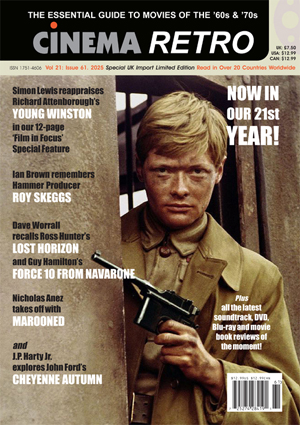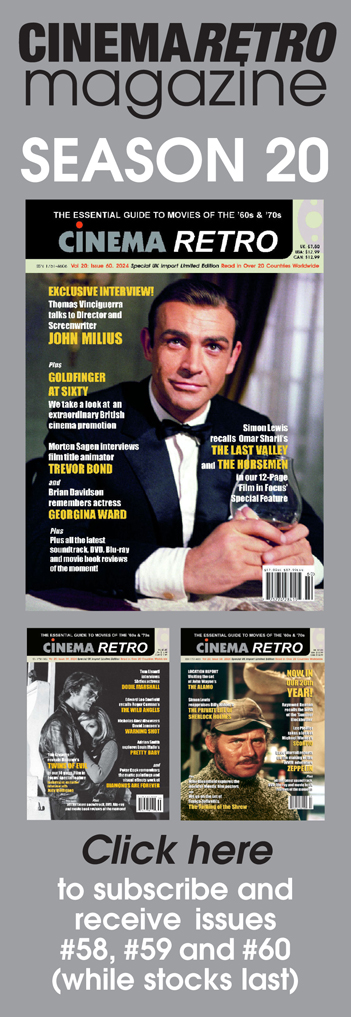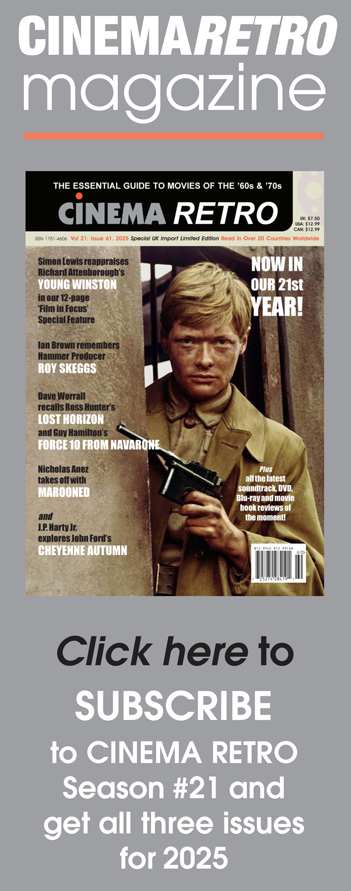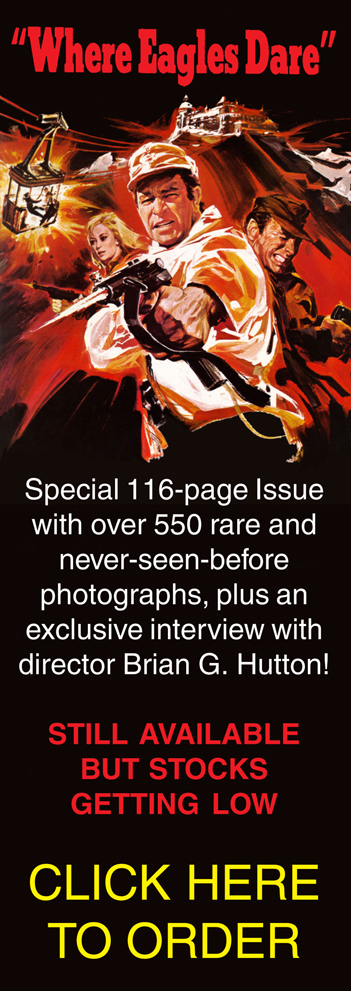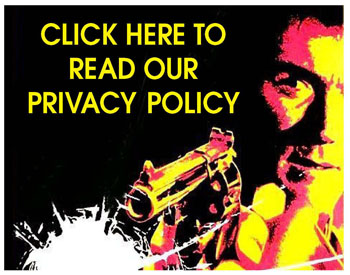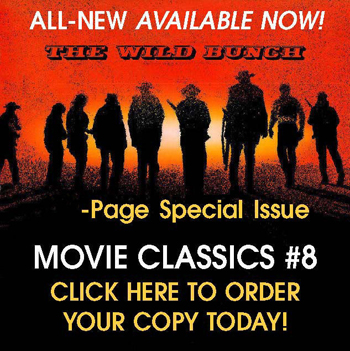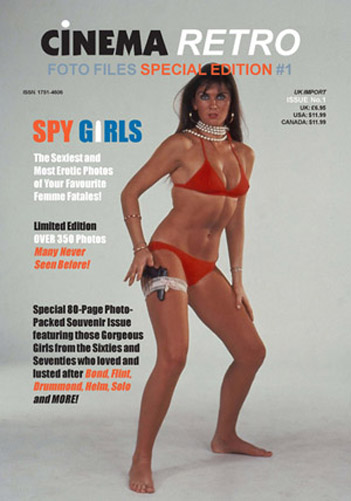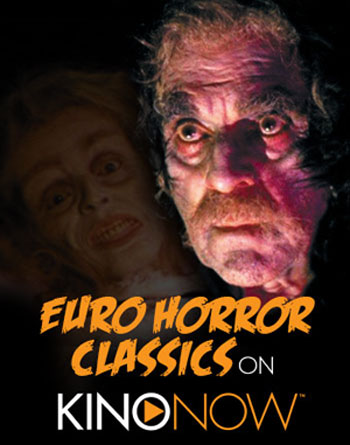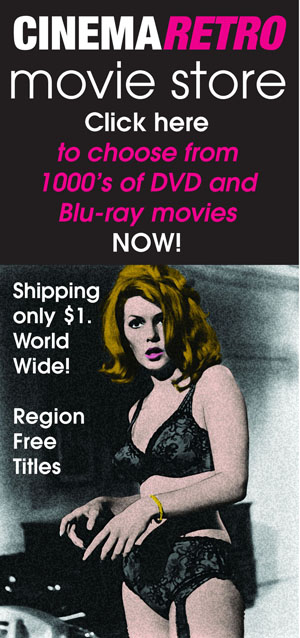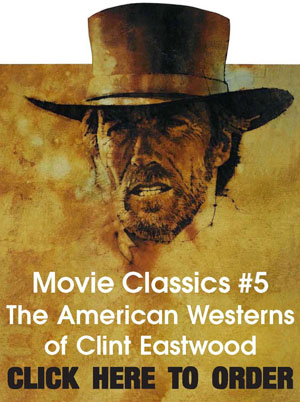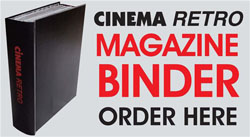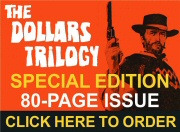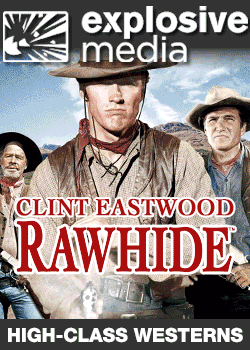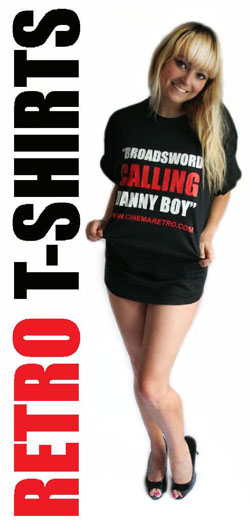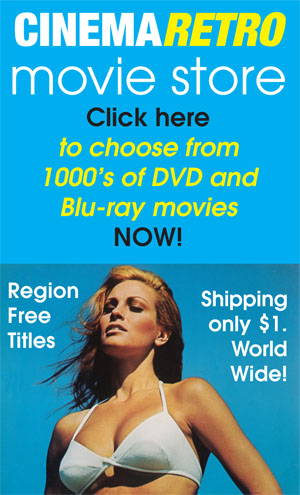RETRO-ACTIVE: THE BEST ARTICLES FROM CINEMA RETRO'S ARCHIVES
Bradford Dillman: A Compulsively Watchable
Actor
By Harvey Chartrand
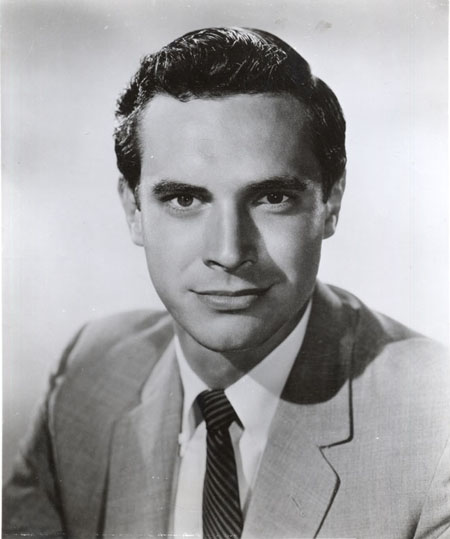
In
a career that has spanned 43 years, Bradford Dillman accumulated more than 500
film and TV credits. The slim, handsome and patrician Dillman may have been the
busiest actor in Hollywood
during the late sixties and early seventies, working non-stop for years. In
1971 alone, Dillman starred in seven full-length feature films. And this
protean output doesn’t include guest appearances on six TV shows that
same year.
Yale-educated
Dillman first drew good notices in the early 1950s on the Broadway stage and in
live TV shows, such as Climax and Kraft Television Theatre. After
making theatrical history playing Edmund Tyrone in the first-ever production of
Eugene O’Neill’s Long Day’s Journey into Night in 1956, Dillman landed the role of blueblood psychopath Artie
Straus in the crime-and-punishment thriller Compulsion (1959), for which
he won a three-way Best Actor Prize at Cannes (sharing the award with co-stars
Dean Stockwell and Orson Welles).
On the And You Call Yourself a
Scientist! Web site, Dillman’s Artie Straus is described as “all brag and
bravado, contemptuous of everything but himself, with his
bridge-and-country-club parents, and his vaguely unwholesome relationship with
his mother.â€
In the early years of
his career, Dillman starred in several major motion pictures, picking and
choosing his roles carefully. He was featured in Jean Negulesco’s romance A
Certain Smile (1958) with Rossano Brazzi and Joan Fontaine; Philip Dunne’s
World War II drama In Love and War (1958) with Robert Wagner and Dana
Wynter; and Tony Richardson’s Sanctuary (1961) with Lee Remick and Yves
Montand, a rancid slice of Southern Gothic based on the novel by William
Faulkner.
Yet in the early sixties, Dillman started
taking any part that came along to support his growing family. From 1962 on, he
guest starred in dozens of TV series -- among them Espionage, Kraft
Suspense Theatre, Twelve O’Clock High, Shane, Felony Squad,
The Man from U.N.C.L.E., Marcus Welby, M.D., The Streets of San
Francisco, Bronk, How the West Was Won and Fantasy Island.
In 1975, Dillman won an Emmy Award for
Outstanding Actor in a Daytime Drama Special for his performance as Matt
Clifton in Last Bride of Salem (1974), an excellent tale of modern
witchcraft. The 90-minute Gothic horror movie aired on ABC Afternoon Playbreak and was so well received that it was
rebroadcast during primetime.
Over the years, Dillman appeared in scores
of made-for-TV movies and theatrical releases, such as Walter Grauman’s drama A
Rage to Live (1965) with the late Suzanne Pleshette; John Guillermin’s war
story The Bridge at Remagen (1969) with George Segal; Hy Averback’s satire
Suppose They Gave a War and Nobody Came (1970) starring Tony Curtis; and
Jud Taylor’s horror-thriller Revenge (1971), with Shelley Winters.
Dillman also played a psychiatrist who goes ape for Natalie Trundy in Don
Taylor’s Escape from the Planet of the Apes (1971) and a scientist battling
firestarting cockroaches in Jeannot Szwarc’s Bug (1975) — the final film
produced by legendary horror schlockmeister William Castle.
Dillman is
now 81. After retiring from acting in 1995, he took up a second career as a writer. He is excellent at his new avocation,
requiring no ghostwriters to tweak his prose. Dillman’s autobiography Are
You Anybody? is a series of amusing anecdotes about his Hollywood
years. He has also written a harrowing adventure tale entitled That Air
Forever Dark, set in Papua New Guinea
and Indonesia.
“It’s a terrifying account of the Jet Age meeting the Stone Age – Deliverance
in a jungle setting,†the actor-turned-author says.
Dillman’s latest book,
published in 2005 by Fithian Press, is a comedy of errors entitled Kissing Kate. “The novel is about an
amateur production of Kiss Me Kate,â€
Dillman relates. “An out-of-work professional actor is hired to play the male
lead opposite a wealthy community icon. Ultimately, of course, they end up
in bed together, where a ‘catastrophe’ occurs and all hell breaks loose. I
assure you that Kissing Kate is not in the least bit autobiographical!â€
Fifty-two years after
appearing on stage in O’Neill’s landmark theatrical event, Dillman is now a
playwright as well. His Seeds in the Wind
made its debut in May 2007 at the Rubicon Theatre Company in Ventura, California.
The play is set in 1939 in Santa Cruz,
California, during a weekend
celebrating the 40th birthday of a society hostess' daughter. The interaction
of the houseguests is both humorous and dramatic, and all manner of unexpected
events occur, Dillman assures us.
The
veteran performer spoke to Cinema Retro
from his home in Santa Barbara,
California.
Cinema
Retro: You achieved
international prominence in Richard Fleischer’s Compulsion, in which you
were unforgettable as the frightening and magnetic Artie Straus, a wealthy
law-school student on trial for murder in this taut
retelling of the infamous Leopold-Loeb case of the 1920s. You had been playing
romantic leads up until then, so this leap into villainy was quite a daring
career move on your part.
Bradford Dillman: I had a commitment to Twentieth Century Fox to do two pictures a
year and, as fate would have it, the timing of the filming of Compulsion coincided.
Nothing to do with the moguls’ belief that I had talent. It was just dumb luck,
pure and simple.
CR:
Following Compulsion, you were often cast in villainous roles. In 1964,
you co-starred with B-movie cult figure John Ashley (The Mad Doctor of Blood
Island) in an episode of Dr. Kildare with the intriguing title Night
of the Beast. What was that one about?
BD: I was the beast. I was such a bad guy I had my
thugs hold Kildare down while I raped his girlfriend in front of his very eyes.
When we came to the comeuppance scene, I learned that Richard Chamberlain had
obviously never been in a fistfight in his life. The stunt men couldn't teach
him how to throw a punch; I couldn't teach him. So we had a gentle comeuppance.
He's a nice, sensitive man who has since come out of the closet.
CR: In 1967, you were the guest villain on The
Prince of Darkness Affair, a two-part episode of The Man from U.N.C.L.E,
later repackaged as a theatrical release – The Helicopter Spies (1968).
You were great fun as Luther Sebastian, the Third Way cult leader who steals a
rocket. Did you have any scenes with
lovely Lola Albright?
BD: The Helicopter Spies has disappeared in
the vortex of remaining brain cells. I don’t remember if I exchanged words with
Lola Albright.
CR: In 1968,
you starred with Harry Guardino in a memorable TV-movie called Jigsaw, a
remake of Mirage (1965), based on the novel Fallen Angel by
Howard Fast. You played Jonathan Fields, an amnesiac who consults a private
eye. This was one of the first made-for-TV movies, featuring a fine cast of Hollywood veterans, including Hope Lange, Pat Hingle,
Victor Jory and Paul Stewart. Any comments about Jigsaw?
BD: Jigsaw was an underrated movie directed
by a much underrated director, James Goldstone. The highlight is a scene where
my character unwittingly ingests LSD, the chemical of choice at that time, and
I go into a sustained freak-out monologue that required a fully-loaded camera
magazine to photograph. Marian Dougherty, who was head of talent at Universal,
later made this required viewing for all the studio contract players, as an
example of how to make material colorful and arresting.
CR:
Congratulations! In 1969, you co-starred with Louis Jourdan in a superb
TV-movie entitled Fear No Evil, about a psychiatrist specializing in the
occult who becomes involved in the case of a man possessed by a spirit in an
antique mirror. In my opinion, Fear No Evil was as good as the classic
anthology movie Dead of Night (1945), which featured an episode with a
similar theme.
BD: Fear No Evil had a pre-Archie Bunker
Carroll O'Connor in it, a down-to-earth guy. It also
had Lynda Day George, with whom I had steamy love scenes. Lynda had the flu.
When I came home that weekend, I passed it along to the entire family. Louis
Jourdan taught me a fascinating word game in which I became his accomplice. We
could convey secret information and astonish people who had no idea how we were
able to baffle them.
CR: In 1971,
you turned up in a two-part episode of The F.B.I. entitled The
Mastermind. Any memories of working with guest stars Clu Gulager, Scott
Marlowe and Steve Ihnat (who died shortly after filming wrapped)?
BD: The Mastermind episode of The F.B.I.
was, I believe, the best episode ever on that long-running series. Gulager,
Marlowe, Ihnat and myself conceive the idea of dressing as cartoon characters
to knock off Disneyland. The first part was
the caper. Part 2 was the feds in pursuit and the consequences of the robbery. I
found Gulager to be a rather eccentric man. Steve Ihnat was taken from us at
far too young an age. He was one of the most brilliant actors I ever worked
with. As for Marlowe, he was a talented actor, but somewhat withdrawn.
CR: You
guest starred in Face of Fear, a 1971 episode of Bonanza. What
was it really like working on the Ponderosa?
BD: As I recall, my Bonanza was practically
all indoors. Lorne Greene was a Canadian who did a screen test with the woman
who later became my wife, Suzy Parker. He was a warm man, very unactor-like.
Michael Landon, of course, later became a household fixture. Dan Blocker was
inseparable from the character he played. As for why the episode was called Face
of Fear, sorry to say that all TV westerns run together in my mind. I was
the heavy in just about all of them, jeopardizing the lives of upstanding
citizens, so I can't be sure if it was Bonanza or The Big
Valley where I held someone prisoner in a well. If Bonanza, then it
was the poor prisoner who had a "Face of Fear."
CR: In 1971, you played the title role in The
Resurrection of Zachary Wheeler, a weird sci-fi action flick starring
Leslie Nielsen and Angie Dickinson. This movie was shot entirely on video, and
looks rather cheesy today. When appearing in such films as Zachary Wheeler,
did you get the sense that you had compromised yourself as an actor, that
(however noble your reasons) you were scraping the bottom of the acting barrel
for parts?
BD: Did I realize a lot of the material I did was schlock? Of course I
did! I was constantly endeavoring to find appropriate choices that might cause
me to disappear – become a hole in the screen. To take you through some of what
I refer to as my ‘atrocities’ – The Swarm was populated by a swarm of
stars prostituting themselves. But how could I point a finger at any of them
when I was the busiest hooker in the game?
Other nifties include three Mexican films (Chosen Survivors, Guyana: Cult of the
Damned and Treasure of the Amazon), the final two flicks I did for
Roger Corman (Heroes Stand Alone, Lords of the Deep), and more
than half the Movies-of-the-Week I turned up in. Dreadful stuff. Awful. But I
defend some others. There’s good stuff out there, too – like The Mephisto Waltz, Brother John, The Iceman
Cometh and The Way We Were.
CR: In 1973,
you starred with George Kennedy in the TV-movie Deliver Us from Evil, about
a group of hunters who stumble across a fortune from an injured skyjacker. This
is an excellent production that really deserves to be released on video or DVD.
Any recollections from this shoot?
BD: I have a legion of memories from Deliver Us
from Evil, filmed in the Mount Hood area of Oregon. Our lodge was so isolated, one snowy
night the producer brought in an auto caravan of young women from Portland, secretaries and
the like, so we could have a party. George Kennedy saved my life when I fell in
river rapids, snatching one arm before I took the swiftest route to Portland.
CR: In 1974,
you co-starred with Hollywood legend Glenn
Ford in The Disappearance of Flight 412 — about a military conspiracy to
cover up UFO sightings, sort of a proto X-Files episode. Could you tell
us about working with Ford in this highly-rated science fiction drama?
BD: The UFO movie with Glenn Ford was shot at Oxnard Airport
and then Edwards Air Force Base. I played a major in the air force. My thrill
was working with Glenn, whom I worshipped in movies like Gilda during my
early movie matinees. He didn't disappoint; a nice man. Though I don't believe
in UFOs, I subsequently learned I am outnumbered.
CR: You had
a good role as a conflicted conspirator in the big-budget thriller Gold (1974),
starring Roger Moore, Susannah York, Ray Milland and John Gielgud. What was
Milland like at this juncture in his career, his days as a leading man long behind
him?
BD: Gold was a big-budget movie, filmed in South Africa and London. Apartheid was
still in force, and Susannah York, a militant liberal, used every publicity
opportunity to deplore the conditions of the black miners, despite pleas from
the producers to cool it. As chief heavy, my demise took place at the peak of a
slagheap where I was run down by a Rolls-Royce. Ray Milland had finally
eschewed a hairpiece, and created here his new persona as a snarling power
broker.
CR: In 1974,
you shot a TV-movie called Last Bride of Salem. I hear it’s quite good
and look forward to seeing it someday on SCREAM Television.
BD: Last Bride was shot in Toronto and environs. I remember Lois
Nettleton was in it, but I especially remember an unknown named John Candy! I
met him again on a golf course after he became a star, and he lied graciously,
saying he remembered me. His golf swing was memorable only for being bad.
CR: You had
a starring role in the Italian-made A Black Ribbon for Deborah (1975),
which sounds like yet another clone of The Exorcist. Describe your role
in this supernatural thriller.
BD: The Italian movie A Black Ribbon for Deborah
was such a clunker I have no memory of the plot. They
dressed me and teased my hair to make me look Italian. I referred to myself as
"Bobby Botticelli." The leading lady was the producer's mistress, and
I recall an embarrassing love
scene where I playfully pull her into a shower for some serious simulated
lovemaking.
CR: Was your co-star Gig Young difficult to work with?
BD: Gig Young was a sad case. All the years of heavy drinking had so taken
their toll that his memory was gone.
CR: What can
you tell me about your starring role in Demon, Demon, a 1975 episode of Wide
World of Mystery, a 90-minute late-night mystery and suspense anthology
series, which ran on ABC? You play an executive who falls in love and marries
his secretary (Juliet Mills). However, he soon begins to suspect that she may
be a demon who is out to possess his soul.
BD: Demon, Demon was taped, and so
hopelessly bad the actors collapsed with laughter
attempting to speak their lines. It's a wonder it could be spliced together.
CR: In the mid-seventies, you made two ‘insect
threat’ movies virtually back-to-back – Bug and The Swarm. You have the honor of starring in the
final film of William Castle, the great horror huckster himself.
BD: Bug is considered laughable by some because William Castle produced it
for $4.50, but it was made at a time when special effects were primitive, and I
believe it’s genuinely scary. Those were real
cockroaches crawling over my bare chest. Bill Castle was a jocular man, always
brandishing a cigar, and in dress he affected a much younger personage.
CR: You and Dean Stockwell worked together again
on a very obscure film called One Away (1976). This crime drama
(directed by Sidney Hayers) sounds like a real curiosity. What was it like to
work with Stockwell again 17 years after Compulsion?
BD: One Away was a biker movie shot in South Africa, about three gypsy
brothers. The Brit Patrick Mower was the third. Dean Stockwell is an expert and
enthusiastic biker. I couldn't ride at all, but my stunt double sure could. I
believe we were escaped convicts who happen upon Elke Sommer. She becomes my
voluptuous love interest. I have the greatest respect for Dean's talent, yet he
and I have never really gotten along. I have a sense he's always resented the
fact I was cast in the Compulsion role played onstage by his friend
Roddy McDowall. For his part, Roddy never held it against me. I worked with
Roddy on Escape from the Planet of the Apes, The Memory of Eva Ryker (1980) and Heroes Stand Alone (1989).
CR: In 1976,
you guest starred on Wonder Woman, with Lynda Carter. The episode was
entitled Wonder Woman Meets Baroness Paula Von Gunther (played by
Christine Belford). Any memories of working on this phenomenally successful TV
series?
BD: My appearance on Wonder Woman is an
example of how desperate I was to put my children through school. I can't
remember if I was being a menace to Lynda Carter, but I would have willingly
joined a line to receive her physical abuse. (laughs)
CR: Mastermind
(1976) sounds like a very strange film. In this comedy thriller, Zero
Mostel plays an inspector on the trail of criminals who have captured a killer
robot. Why did you agree to appear in Mastermind?
BD: Mastermind was shot in Japan in 1969
and not released until 1976, and then just barely. I believe Mastermind was stuffed in a
time capsule and dropped somewhere off Okinawa.
(laughs) I did it to get to Japan, but who could resist working
with that superb cuckoo, Zero Mostel? I have a memory of dueling with him while
in a samurai costume. Inside the killer robot was a midget.
CR: You then
co-starred with Robert Mitchum in The Amsterdam Kill (1977), directed by
Robert Clouse, who specialized in chopsocky pictures. Describe your role in
this production and what it was like to work with Mitchum and Richard Egan.
BD: The Amsterdam Kill was two movies made
at the same time. Ours was shot in Hong Kong.
Mitchum and Egan were both tough guys, on and off screen. You didn't want to be
around either of them when they were inebriated, and that was frequently.
Mitchum played pranks on the deaf director Clouse. I did The Amsterdam Kill to get my wife a trip to the Orient.
CR: You
played President Abraham Lincoln’s assassin, the actor John Wilkes Booth, in The
Lincoln Conspiracy (1977). How did you tackle this demanding role?
BD: Playing Booth was fun, carte blanche for ham
acting. The Lincoln Conspiracy was shot in Savannah because of the ante-bellum
architecture, including cobblestoned streets that presented a horsemanship
hazard. My mustache looked like a bat had died on my lip.
CR: Did you
agree to a supporting role in Love and Bullets (1979), a Charles Bronson
actioner, because it was to have been directed by John Huston, who bowed out
and was replaced by Stuart Rosenberg?
BD: I agreed to Love and Bullets because my
acting confidence had just been shattered by Irwin Allen on the set of The
Swarm (1978). He pre-plotted all his camera angles from drawings and knew
exactly how he wanted the actors to look and sound in each scene. All acting
creativity was eviscerated. An actor was sent straight back to kindergarten,
miming and speaking in a programmed manner. Stuart Rosenberg was an old friend
from the golden days of early TV, and it was a chance to see Switzerland.
CR: Anything you can tell us about working with Bronson?
BD: Bronson was a pleasant person, as was his wife, Jill Ireland.
CR: Did you have any scenes with Rod Steiger, who
played a gangster?
BD: I had no scenes with Steiger, but he has always
been one of my all-time favorite actors for having the courage to be bad.
CR: In 1979,
you guest starred on Bill Bixby’s series The Incredible Hulk, in an
episode entitled The Snare. What was Bixby like to work with?
BD: The Incredible Hulk was a joy. It's the
old "hunt a human" story redone, but it was done wonderfully here.
Bill Bixby, taken from us far too early, was a gentleman in the best sense, a
"gentle man" who was intelligent and gifted, as well as a fellow San
Franciscan. We compared notes on having won Gold Pin at Miss Miller's School of Dance. The hulk, Lou Ferrigno, was so
uncoordinated that I worried when he had to retrieve my corpse. I feared he'd
drop me.
CR: You were
certainly turning up in a lot of genre television in the late seventies and
early eighties. In 1980, you guest starred in an episode of Charlie’s Angels
— Angels of the Deep — with Sonny Bono and genre staples Anne Francis (Forbidden
Planet) and Gary Lockwood (2001). Any memories you’d like to share
about this assignment?
BD: Charlie's Angels endures in my memory
because, for all the beauty of the leading ladies, none held a candle to the
wife of the director (Kim Manners). She was maybe the sexiest-looking lady I've
ever seen. And how many guys can claim they actually worked with Sonny Bono?
CR: Director
René Cardona, Jr. assembled a great cast for his 1985 adventure/horror movie Treasure
of the Amazon. What are your recollections of working with the late,
lamented Donald Pleasence and John Ireland?
BD: Treasure of the Amazon was the second
movie I did in Mexico
for René Cardona, who had a knack for getting semi-names to agree to do crap at
the risk of Montezuma's revenge. John Ireland I knew as a fellow Montecitan, a
guy who cheated local merchants by never paying his bills. Donald Pleasence was
a quirky scene-stealer. In my memoir, I describe how he got hoisted on his own
petard by scenes with an Amazonian who had the biggest boobs in Mexico. Donald
came up to her nipples, bested for screen attention before he could speak
CR: Tell us
about your writing career subsequent to retiring from acting in 1995.
BD: My first book, Inside the New York Giants, is a football scouting grading system. Are You Anybody? is a memoir. Then I wrote a spoof called Dropkick, in which I anticipate the first female football player. That Air Forever Dark is a very macabre adventure story. And my latest novel, Kissing Kate, is a funny tale of an aging star of stage and screen who is recruited for a wealthy community's amateur production of Cole Porter's Kiss Me Kate. I just finished adapting my unpublished novel, Beneath the Third Waterfall, into a play entitled Seeds in the Wind. The novel traces the longstanding friendship of two women who meet first during the San Francisco earthquake and fire of 1906. So creatively speaking, I'm still breathing. I keep busy and I'm happy.
(Harvey Chartrand recently interviewed Nehemiah Persoff for Cinema Retro) 
